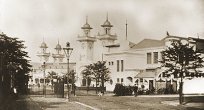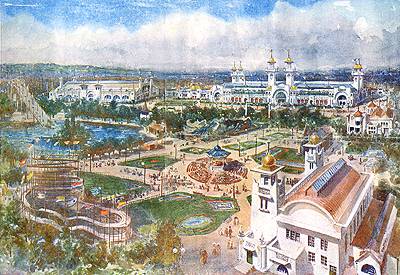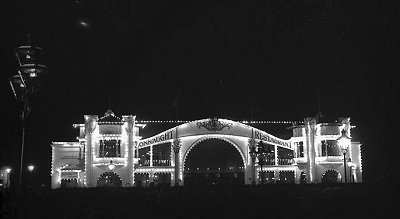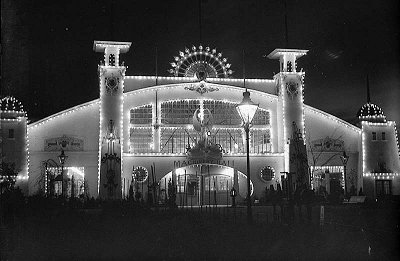 |
Through Glass Darkly
by Robin Imray
|
 |
|
© This article is copyright Robin Imray, July 2007 and no
part of it may be reproduced without the permission of its author.
|
|
106
years ago, Wolverhampton had its own "Dome" moment. The
six-month long Art & Industry Exhibition was meant to show-case
Midland talent and manufacturing. It was, though, bedevilled by
poor attendance, appalling weather, and problems with sideshows.
It lost over £34,000 - two and a quarter million pounds in
modern terms. |
 |
A general view of the Wolverhampton Art and Industrial
Exhibition, 1902 by George Phoenix. |
|
From the
beginning, the press carped. About the opening on May 1st, 1902, the
Midland Weekly News complained that "the Royal procession was not
longer and more imposing. The Wolverhampton authorities are entirely
to blame in this matter". A week later, it noted that bad weather
and low attendance "afforded a good deal of the Exhibition which was
incomplete after the opening to be put in order".
There was other
discontent. Under the headline "Wolverhampton's Isolation", Bilston
District Council complained about a lack of public transport: "A
great many people would have taken tickets if there had been a
better means of getting to it". But the show went on: the Coldstream
Guards played, a young John Masefield, later Poet Laureate, ran the
Art Gallery (and wrote
Cargoes,
with its theme of changing trade, at Tettenhall that year). The Boer
war ended, Emile Zola died, southern white Americans lynched blacks,
and a "Mad Mullah" caused trouble in Somaliland. Here, the King fell
ill and postponed his Coronation, a Prime Minister resigned, there
were executions (frequently), and in Wednesfield a man was fined
12/- for using bad language in his bedroom (he was cursing his wife,
and two passing policemen heard him through a window).
The
Exhibition added attractions to try and boost attendance - elephant
rides, high diving into the lake, glass-blowing demonstrations. Most
especially, for the Coronation, they added 20,000 lights - "Royal
Ediswan Lamps, used throughout in the lighting and decoration".
"Talk about fairyland," remarked a visitor, and the Weekly News
spoke of "lines of glowing fire".
A century
on, some remarkable photographs have emerged to show this fairyland.
With views new even to the Wolverhampton archives, they are part of
a collection of glass negatives found in a Devon jumble sale.
Packed
loosely into shoe boxes, the collection had been neglected for
decades. The problem was that as negatives they were hard to
understand, and, being glass, would cost a lot to print. Only when
computers and scanners came along did it become relatively easy to
study them. They show buildings (grand city ones and cottages),
bridges, and stiffly posed Edwardians in high collars and big hats.
But with no captions and no major landmarks, they could be almost
anywhere. Detective work is called for.
There are
some clues. Separating the glass plates were scraps of paper. Most
were tissues, but there is a flyer for E. Mentor & Co,
photographers, with " studios at 213, Moseley Road, Birmingham"; a
compliments slip from Riley and Smith, of Colmore Row, and a torn-up
draft letter about a fire at Thickbroom Farm, Weeford ("We looked
into the damage with Mr Thorneycroft ..."). There are also details
in the pictures. Old 5"x4" negatives have extraordinarily fine
grain, and careful scanning at high resolution makes the smallest
letters readable. So a pub is called the Fighting Cocks, street
names say Colmore Row and Waterloo Street, and one of the mysterious
but stunning illuminated pavilions proclaims the Connaught
Restaurant. It's enough to get you going on the internet.
|
|
The Connaught
Restaurant with the arch leading to the bandstand in the
middle. |
 |
|
And so to
Google. Type in "Colmore Row", and in well under a second 82,000
references make clear that this is indeed Birmingham. Check a street
plan, and you'll find a corner with Waterloo Street, just as in the
photo. "Fighting Cocks" offers a few hundred thousand possibilities,
including a pub in Moseley Road and a photo to confirm it is right.
Most importantly, "Connaught Restaurant" takes you to the
Wolverhampton Exhibition, with mentions, too, of Machinery and
Industrial Halls. |
|

The Industrial Hall. |
We have a
place, and, from the date of the Exhibition, a year. Circling round
the area, it gets easier to identify other pictures, not least
because you can email them to local libraries, historians and other
specialists.
A website covering the River Severn identifies one
bridge as Bewdley, and another, iron, one as carrying water pipes
near Trimpley - our 1900 photo shows this pipe bridge being built.
There is Aston Hall, the Birmingham College of Arts and Crafts, and
Chamberlain Square (with a bowler-hatted workman crossing frame).
One stray image is from Nottingham, a fine half-timbered building
where Wheeler Gate joined Beast Market Hill. |
|
Slowly a
theme emerges, still largely guess-work, but with an increasing base
of fact. Local directories tell us Riley and Smith were loss
adjusters and fire assessors. Looking through the photographs of
buildings, some are derelict. One, probably a shop (it has a Fry's
Chocolate plaque outside) is thoroughly destroyed. Two, almost
identical, images are of Colmore Row - rather dull ones of a corner
building. There is something very deliberate about taking two dull
photos. May be it is relevant that the street then was full of
insurance businesses? The Nottingham building also contains
insurance offices. Was our photographer in this line of work? Did he
use the camera in his job, to record fire damage? Looking at the
posed Edwardians, you can imagine it - solid people, men with pipes
and square-jawed women. Photos show them in the countryside; one has
a couple rowing. Well-dressed, well-found, they are very much the
image of success that the 1902 Exhibition was designed to celebrate. |
|
A weekly
magazine appeared that summer. The Wolverhampton Exhibition
Pictorial was a little thing of background articles and
faits divers
covering
the exhibition. In its first issue, the
Note Book
column
comments on
"the
ubiquity of the snapshottist
in
the grounds ... numerous pocket cameras produced from the recesses
of overcoats", and it goes on to wonder if "they will all turn out".
We can be
grateful for the care and practice of our "insurance" man. His
photos did come out; and despite the risks of a century of war and
change, they are still there, telling their tale of "fairyland".
|

The Machinery
Hall. |
 |
A photograph of two couples, from
the same collection of glass negatives. Could one
of the men be "the insurance man"? |
Anyone who can shed any further light on the photographer and the
photographs mentioned in this article is invited to make contact
with the author at: robin@imray.eu
|

|
|
Return to the
previous page |
|